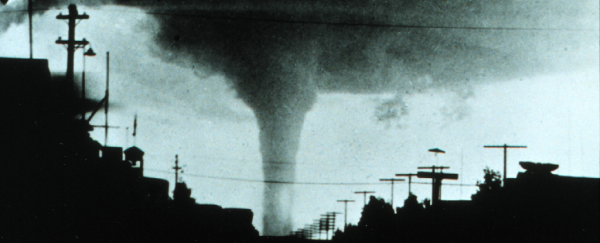In the lead-up to violent storms and cyclones, it's common for residents to try and defend their dwellings with makeshift plywood barriers designed to protect their glass windows, but just how effective is plywood sheeting at keeping out flying debris?
According to a new analysis by scientists at Australia's James Cook University (JCU), plywood barriers will indeed protect you from strong winds and the flotsam they carry – but only up to a point.
Using JCU's windborne debris generator at its Cyclone Testing Station, the researchers fired 4-kg blocks of wood at 17-mm-thick standard plywood at a range of speeds to find the limit of this relatively cheap and simple defence.
"It will resist debris typically produced by a Category Two cyclone," said one of the team, Nimesh Fernando. "Based on experimentation, we wouldn't recommend local plywood for anything above that."
Plywood did its job effectively at shielding hurtling wooden debris, but once the blocks were fired at the sheeting at speeds of over 14 metres per second (around 50 km/h or 31 mph), they pierced through the barrier.
"Based on Australian Standards, it would take a wind speed of 120 or 130 kmh, which is typical for a Category Two storm, to pick up such an object and project it at 50 km/h," said Fernando.
However, while the researchers only tested 17-mm-thick standard plywood in their experiments, they expect that thicker plywood barriers would provide greater defensive properties for more violent storms.
"We didn't specifically model or test it, but we anticipate that a higher grade marine plywood should protect from debris produced by a low Category Three storm," said Fernando.
The team advises checking the strength rating of plywood when purchasing – in Australia, this is designated by an F-grade rating marked on the wood. In the case of 17-mm-thick plywood, the strength rating is F17 (a higher number is better).
But even though thin plywood might not be strong enough to shield windows from all debris in particularly intense storms and cyclones, the researchers say that the dulling effects of inexpensive sheeting ensures that it's a better idea than no protection at all.
"Even in the cases where the projectile passed through the plywood," said Fernando, "it had lost 80 percent of its velocity by the time it reached the other side."
In addition to gauging the effectiveness of 17-mm-thick plywood, the researchers corroborated the physical results with a computer model that can simulate the effects of hurled debris.
The end result of their research is a digital system that now makes it easier and more cost-effective to test the effectiveness of barrier impacts virtually, instead of by physically firing wooden blocks out of a cannon (fun though that might sound).
"We validated the simulations with newly acquired physical test data. There are some improvements to be made, but we have created the platform for future impact testing of debris shields," said Fernando. "The benefit of the numerical method developed as part of this project is its capacity to test different species, thickness and sizes of plywood for any projectile by modelling, rather than having to repeat the expensive and time consuming physical testing."
James Cook University is a sponsor of ScienceAlert. Find out more about their research.
